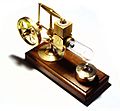External combustion engine facts for kids
An external combustion engine, often called an EC engine, is a machine that turns heat into movement. Imagine heating up a fluid, like air, hot water, or even liquid sodium, in a special container called a boiler. This heated fluid then expands and pushes parts of the engine, making it move.
These engines are different from internal combustion engines. In an internal engine, fuel burns *inside* the engine to create an explosion that causes movement. But in an external engine, the fuel burns *outside* the main working parts. The heat from this outside burning is then used to heat a separate fluid, which does the work. This extra step is what makes it an "external" combustion engine.
Contents
How They Work
All combustion engines aim to turn fuel into motion. Internal combustion engines do this by exploding fuel directly inside the engine. External combustion engines, however, use the energy from burning fuel to heat a gas or liquid. This heated gas or liquid then expands, creating the motion. This extra step of heating a separate fluid is the key difference.
External combustion engines were invented before internal ones. Famous examples include the old steam engines that powered trains and factories.
Types of Engines
There are two main types of external combustion engines: single-phase and dual-phase. They differ in how the working fluid changes.
Single-Phase Engines
In a single-phase engine, fuel is burned to heat a gas. This hot gas then expands and creates movement. The important thing here is that the gas stays a gas; it doesn't change into a liquid or another phase. There is no "phase change" involved in how it works.
Dual-Phase Engines
Dual-phase engines are a bit more complex. They use an extra step called a "phase transition." This means the working fluid changes its state, usually from a liquid to a gas. For example, water is heated until it turns into steam (a gas). This steam then expands and pushes parts of the engine. After doing its work, the steam is often cooled back into a liquid and reused.
Common examples of dual-phase engines are classic steam engines and engines that use something called the Organic Rankine Cycle.
Famous Examples
The most well-known external combustion engines are steam engines. These powerful machines were crucial during the Industrial Revolution. They powered trains, boats, and factory machinery for many years.
Another example is the Stirling engine. This engine uses a closed cycle, meaning the same gas (like air or helium) is heated and cooled repeatedly to create motion. It's known for being quiet and able to run on almost any heat source.
Images for kids
-
Model Stirling engine, with external heat from a spirit lamp (bottom right) applied to the outside of the glass displacer cylinder.
-
Newcomen's engine, a precursor of the steam engine, with the boiler heated from beneath
-
Sectioned steam locomotive. Although the fire is within an enclosed firebox, this is still an external combustion engine, as the exhaust gas and the steam working fluid are kept separate.
See also
 In Spanish: Motor de combustión externa para niños
In Spanish: Motor de combustión externa para niños




